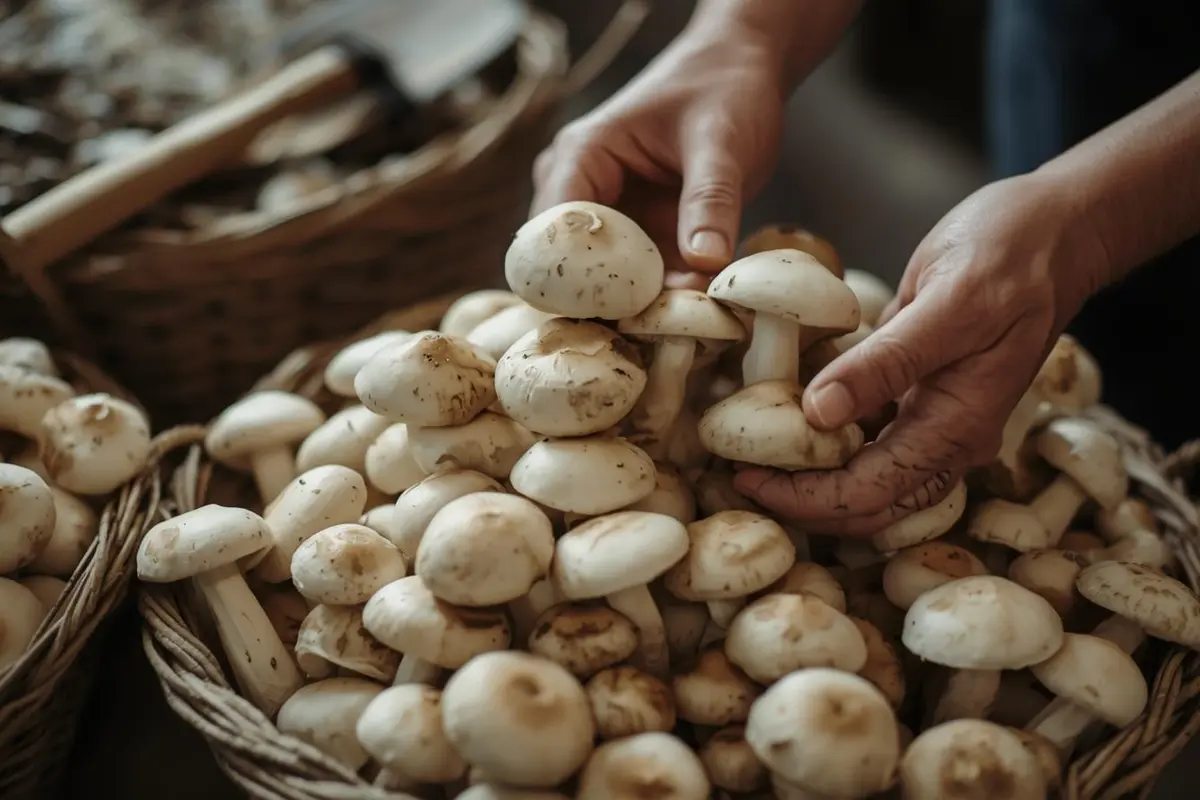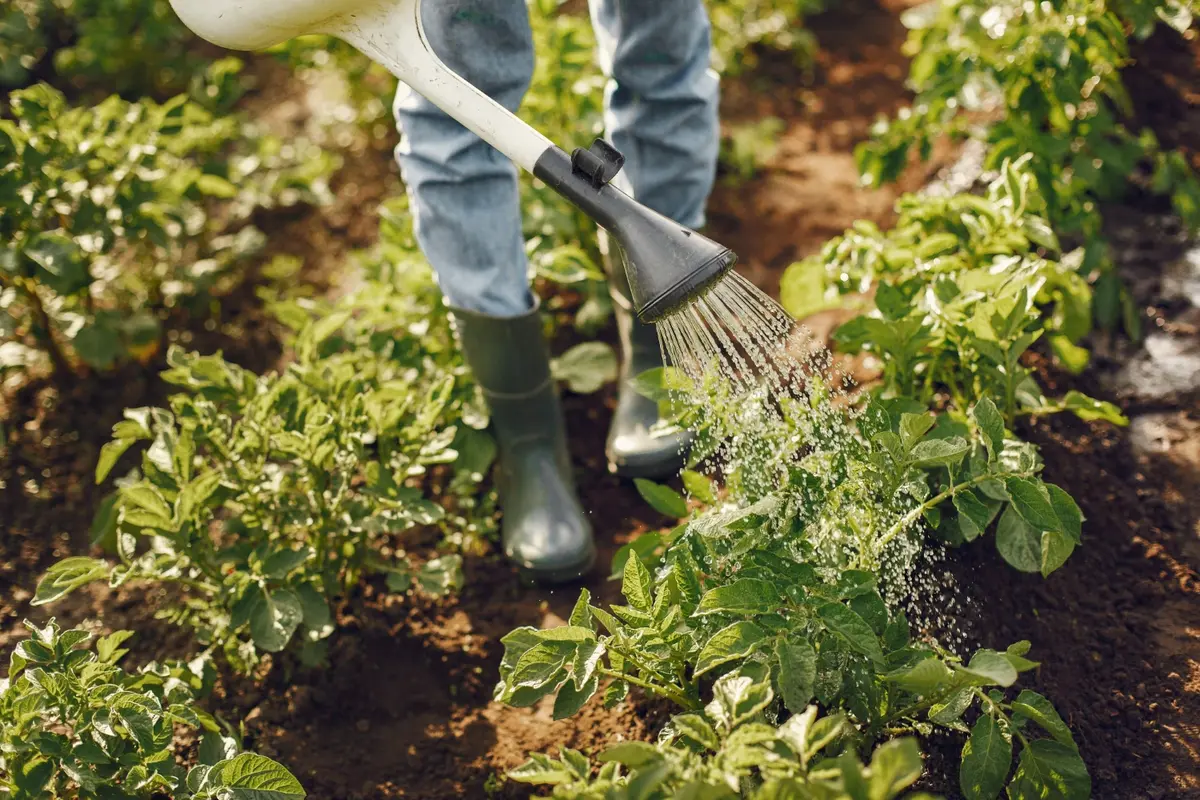Agriculture is no longer just about traditional farming, it has transformed into a profitable industry with numerous money-making opportunities. With rising demand for organic produce, specialty crops, and value-added farm products, entrepreneurs can build successful businesses in the agricultural sector. Whether you have a large farm or a small plot of land, there are countless ways to generate income, from greenhouse farming to agritourism. In this article, we’ll explore some of the best money making agriculture business ideas that can help you turn farming into a profitable enterprise.
Table of Contents
1. Organic Vegetable Farming

Organic vegetable farming is a profitable and sustainable agricultural business that focuses on growing vegetables without the use of synthetic pesticides, fertilizers, or genetically modified organisms (GMOs). Instead, it relies on natural compost, crop rotation, biological pest control, and eco-friendly farming techniques to maintain soil health and enhance crop productivity. With the increasing consumer preference for chemical-free and healthy food, organic vegetables have a high market demand, making this a lucrative business opportunity. Farmers can start small, using backyard spaces, rooftop gardens, or small plots of land, and expand gradually.
How to Start Organic Vegetable Farming
- Study organic farming techniques and government regulations.
- Analyze market demand for organic produce.
- Choose an appropriate land location with good water access.
- Identify suitable vegetables for your region’s climate and soil.
- Conduct soil testing to check fertility and pH levels.
- Use natural methods to enrich soil, like compost, manure, and green manure.
- Select certified organic seeds or heirloom varieties and avoid genetically modified seeds.
- Use compost, vermicompost, organic manure, and bio-fertilizers.
- Use natural pesticides like neem oil and garlic spray.
- Harvest at the right stage for maximum freshness and nutrients.
- Obtain organic certification from local authorities.
How to Sell The Product
- Sell at local farmers’ markets to attract health-conscious customers.
- Set up a roadside farm stand or home delivery service.
- Create an Instagram or Facebook page to showcase fresh produce.
- List products on e-commerce platforms like Amazon, or local organic marketplaces.
- Partner with supermarkets to sell under a branded organic section.
- Make organic pickles, dried vegetables, or fresh juices for additional revenue.
2. Mushroom Farming
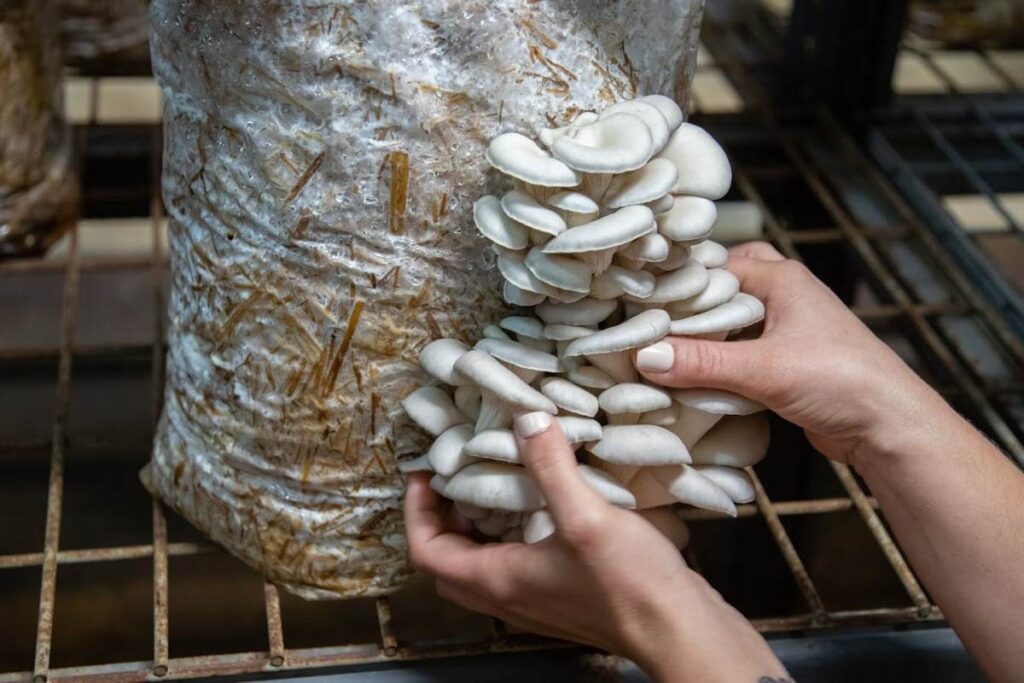
Mushroom farming is a profitable and sustainable agricultural practice that involves cultivating various types of mushrooms, such as button, oyster, and shiitake, in controlled environments. It requires minimal space and investment compared to traditional farming. The process includes preparing a substrate (such as straw or sawdust), inoculating it with mushroom spores, and maintaining proper temperature, humidity, and ventilation for optimal growth. Mushrooms grow quickly, often ready for harvest within a few weeks.It is an eco-friendly business that utilizes agricultural waste effectively while offering a nutritious, high-value crop.
How to Start Mushroom Farming
- Choose the type of mushroom (button, oyster, shiitake, milky, etc.).
- Study the climate and space requirements for the selected variety.
- Ensure proper ventilation, humidity, and temperature control.
- Use suitable substrate materials like straw, sawdust, coffee grounds, or compost.
- Purchase high-quality mushroom spawn from a certified supplier.
- Keep humidity between 70-90% and temperature according to the mushroom type.
- Maintain proper darkness during the incubation period (10-20 days).
- Harvest mushrooms carefully by twisting or cutting them at the base.
How to Sell The Product
- Sell fresh mushrooms at nearby vegetable markets.
- Partner with local restaurants, cafes, and hotels that use fresh mushrooms.
- Create an Instagram or Facebook page to showcase fresh produce.
- List products on e-commerce platforms like Amazon, or local organic food marketplaces.
- Sell dried mushrooms, mushroom powder, or mushroom pickles.
- Make and market mushroom-based snacks or health supplements.
- Offer farm tours and direct sales from the farm to customers.
- Supply to government food programs, schools, and hospitals.
3. Poultry Farming
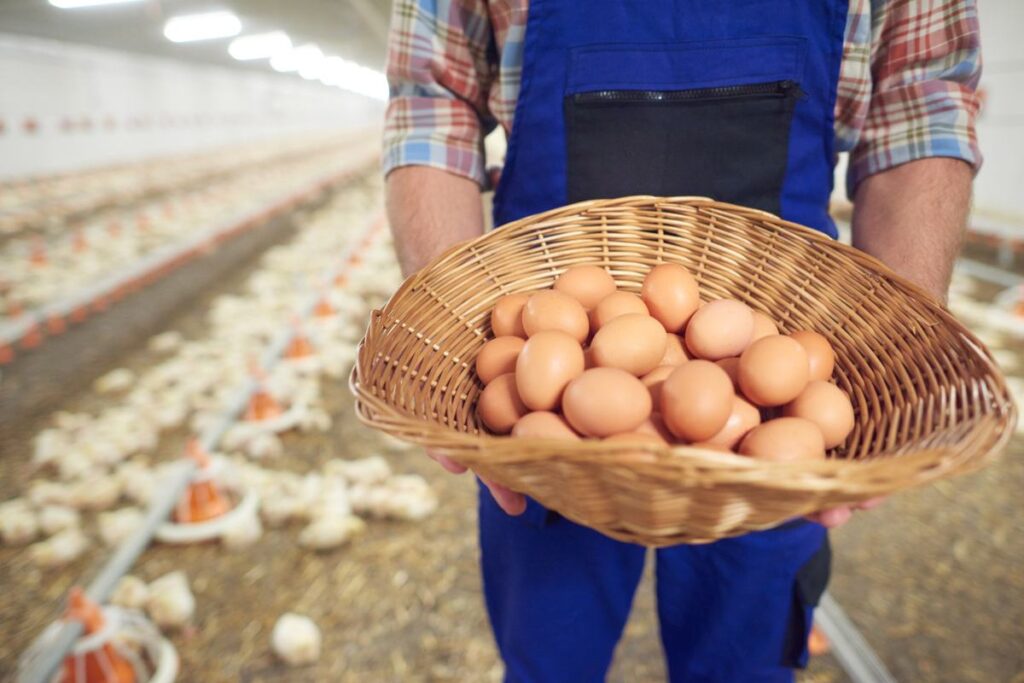
Poultry farming is a profitable agricultural business that involves raising domesticated birds such as chickens, ducks, turkeys, and quails for meat (broilers) or egg production (layers). It requires proper planning, including selecting the right breed, setting up a well-ventilated and hygienic poultry house, and providing balanced nutrition, clean water, and disease control measures. Modern poultry farming practices, such as free-range, organic, and intensive systems, help maximize productivity. Proper management, bio-security, and marketing strategies are essential for running a successful poultry farming business.
How to Start Poultry Farming
- Decide the type of poultry farming (broilers for meat or layers for eggs).
- Choose suitable poultry breeds based on your goals (e.g., White Leghorn for eggs, Cornish Cross for meat).
- Study local regulations and obtain necessary licenses or permits.
- Analyze market demand and competition.
- Select a spacious location with good ventilation and drainage.
- Build a well-structured poultry house (deep litter, cage system, or free-range).
- Install necessary equipment like feeders, waterers, and lighting systems.
- Buy healthy chicks from certified hatcheries.
- Provide a high-quality, balanced diet with proteins, vitamins, and minerals.
- Vaccinate birds against common poultry diseases (Newcastle, Marek’s, etc.).
How to Sell The Product
- Sell live or dressed chickens at nearby wholesale and retail markets.
- Supply fresh eggs directly to local vendors and customers.
- Partner with local restaurants, fast food chains, and hotels.
- Approach supermarkets and grocery stores to stock packaged chicken and eggs.
- Set up a small shop or home delivery service for fresh eggs and meat.
- Promote on social media (Facebook, Instagram, WhatsApp) for direct sales.
- List products on online grocery stores like Amazon Fresh, or local e-commerce sites.
- Partner with schools, hospitals, and corporate canteens for bulk supply.
- Sell frozen, marinated, or pre-cooked chicken products.
4. Beekeeping
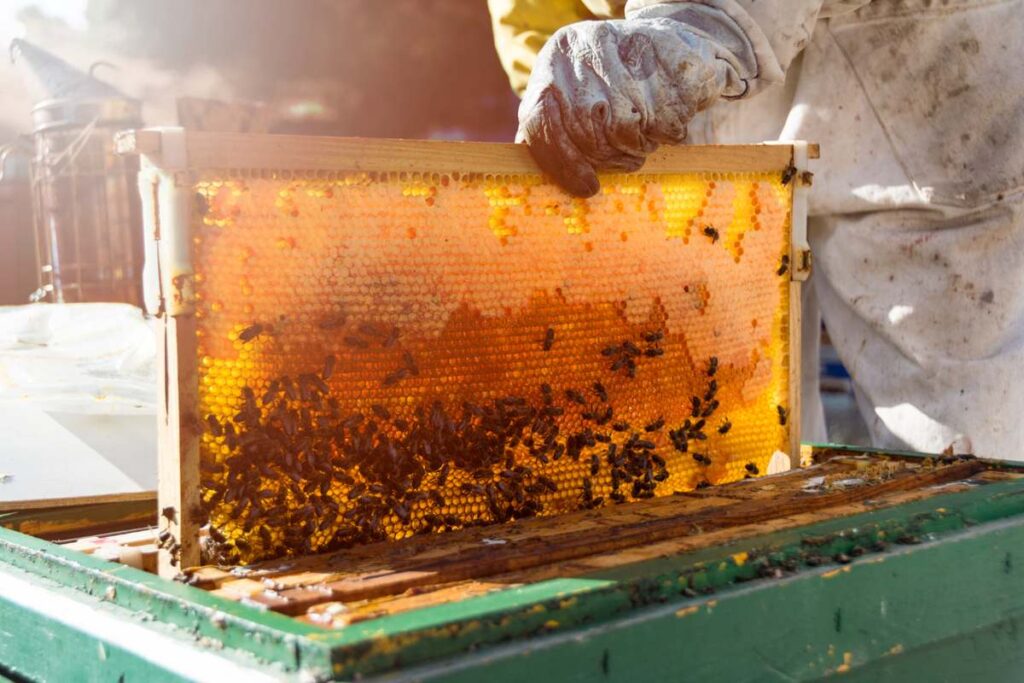
Beekeeping, also known as apiculture, is the practice of raising and managing honeybee colonies for honey production, pollination services, and other bee-related products like beeswax, propolis, and royal jelly. It requires setting up bee colonies in hives, ensuring a safe and pesticide-free environment, and providing proper nutrition for the bees. Beekeepers must regularly inspect the hives to prevent diseases, manage swarming, and optimize honey production. With the growing demand for organic honey and pollination services, beekeeping can be a profitable and sustainable agricultural business.
How to Start Beekeeping
- Learn about different bee species and select the right one (e.g., Apis mellifera for honey production).
- Understand local beekeeping laws and regulations.
- Identify a suitable location for setting up beehives (preferably near flowering plants and water sources).
- Purchase essential tools like beehives, bee suits, gloves, smokers, and hive tools.
- Buy bee colonies or nucleus hives (nucs) from a reputable beekeeper.
- Capture wild bee swarms (if permitted by law) or split an existing colony.
- Place hives in a sunny, dry, and predator-free area.
- Ensure bees have access to flowering plants for nectar and pollen.
- Harvest honey when honeycombs are fully capped (sealed with beeswax).
How to Sell The Product
- Sell fresh, raw honey at local farmers’ markets.
- Supply honey and other bee products to grocery stores and organic food shops.
- Partner with supermarkets and health food stores to stock packaged honey.
- Promote on WhatsApp, Facebook, and Instagram for direct sales.
- Create a website or online store to sell honey, beeswax, and other products.
- List products on Amazon, or other e-commerce platforms.
- Partner with restaurants, cafes, and bakeries that use honey in their recipes.
- Make beeswax candles, lip balms, or skin care products for extra profit.
- Rent bee colonies to farmers for pollination services.
- Partner with agricultural businesses that require pollination for better crop yield.
5. Goat Farming
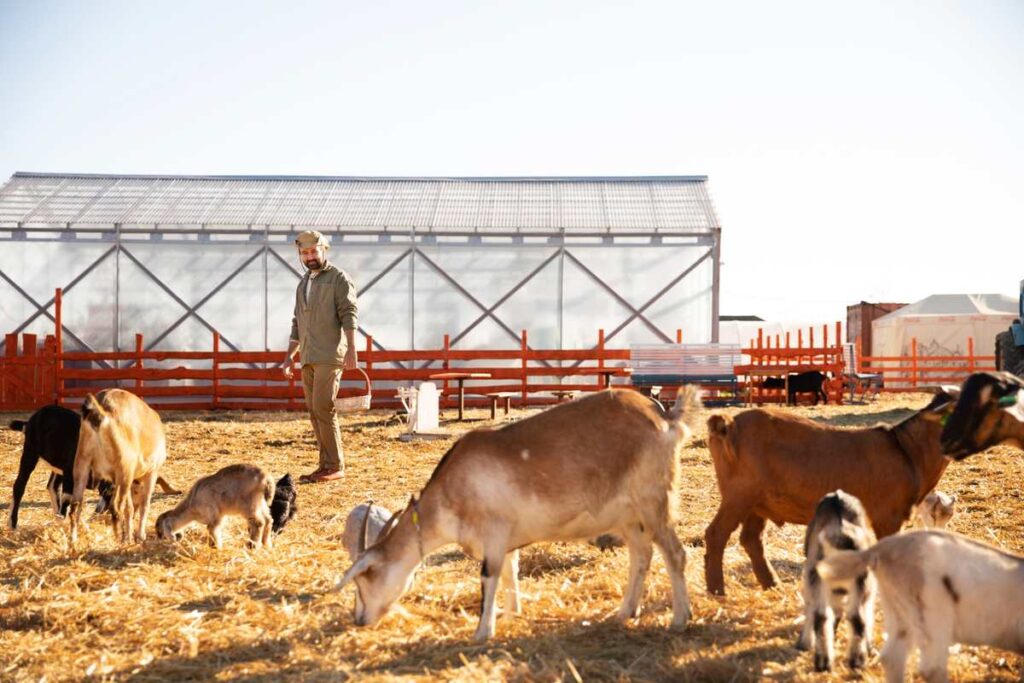
Goat farming is a profitable and sustainable livestock business that involves raising goats for meat, milk, fiber, or breeding purposes. It requires selecting high-yield breeds like Boer or Sirohi, providing proper shelter, balanced nutrition, and regular healthcare to ensure healthy growth. Goats are hardy animals that adapt well to various climatic conditions and require relatively low investment compared to other livestock. Proper herd management, disease control, and marketing strategies can make goat farming a lucrative agricultural venture.
How to Start Goat Farming
- Decide the purpose of goat farming (meat, milk, fiber, or breeding).
- Select high-yield goat breeds based on your goal (e.g., Boer for meat, Saanen for milk)
- Study local climate, market demand, and government regulations.
- Choose a spacious, well-drained area with access to clean water.
- Ensure proper ventilation and shade for goats.
- Install feeding troughs, water containers, and fencing for safety.
- Buy healthy goats from a reputable breeder or livestock market.
- Select disease-resistant and fast-growing breeds.
- Provide a balanced diet of green fodder, dry hay, and concentrate feeds.
- Implement a regular vaccination and deworming schedule.
How to Sell The Product
- Sell goats directly at local livestock markets.
- Supply live goats to butcher shops, slaughterhouses, and meat processors.
- Partner with local meat shops, restaurants, and hotels.
- Supply fresh or frozen goat meat to supermarkets and grocery stores.
- Supply fresh goat milk to local dairies, organic stores, and households.
- Process and sell goat-based dairy products like cheese, yogurt, ghee, and butter.
- Sell fiber from breeds like Cashmere and Angora to textile industries.
- Process raw fiber into finished goods like scarves, shawls, and blankets.
- Package and sell goat manure to farmers, gardeners, and organic farming enthusiasts.
- Supply bulk manure to agricultural cooperatives and nurseries.
- Create a website or social media page to market farm products.
- Use e-commerce platforms to sell processed goat meat, dairy, and fiber.
6. Hydroponic Farming
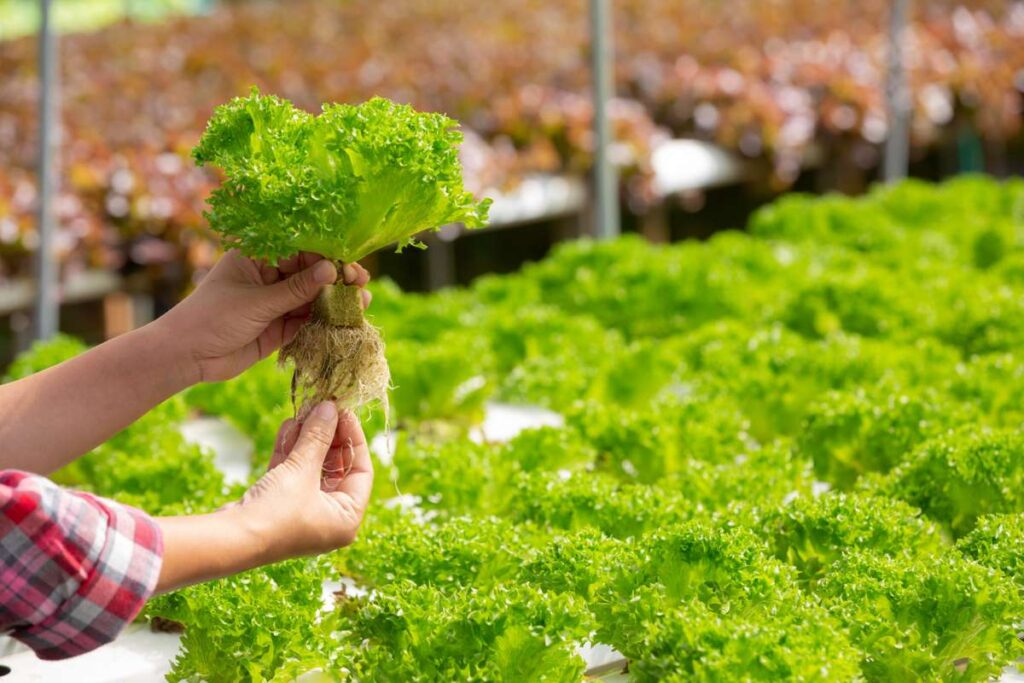
Hydroponic farming is a modern, soil-less agricultural technique where plants grow in nutrient-rich water solutions instead of traditional soil. This method allows for faster plant growth, higher yields, and efficient use of water and space, making it ideal for urban farming and areas with poor soil conditions. Hydroponic systems, such as nutrient film technique (NFT), deep water culture (DWC), and aeroponics, provide controlled environments that minimize pests and diseases, reducing the need for chemical pesticides. Commonly grown crops include leafy greens, herbs, tomatoes, and strawberries. With increasing demand for fresh, pesticide-free produce, hydroponic farming presents a sustainable and profitable solution for future food production.
How to Start Hydroponic Farming
- Learn about different hydroponic systems (NFT, DWC, aeroponics, drip systems).
- Decide the crops to grow (lettuce, spinach, herbs, tomatoes, strawberries).
- Analyze market demand and potential profitability.
- Select an indoor, greenhouse, or rooftop location with good lighting.
- Install grow trays, nutrient reservoirs, and water pumps.
- Set up artificial lighting (LED grow lights) if growing indoors.
- Use a balanced hydroponic nutrient mix containing essential minerals.
- Adjust pH levels (5.5 – 6.5) for optimal plant absorption.
- Regularly check and maintain nutrient concentration (EC levels).
- Harvest crops at peak freshness for better taste and quality.
How to Sell The Product
- Partner with local grocery stores, supermarkets, and organic food stores.
- Approach restaurants, cafes, and hotels that prefer fresh, high-quality vegetables.
- Build a website or Instagram store to sell directly to consumers.
- Partner with organic food shops, health stores, and diet-focused outlets.
- Set up a stall at local farmers’ markets or organic food fairs.
- Sell directly from the farm through a farm shop or pickup service.
- Allow customers to visit the farm and select fresh produce.
- Partner with export companies for large-scale distribution.
- Collaborate with influencers and health bloggers to promote the produce.
7. Plant Nursery Business

A Plant Nursery Business involves growing and selling a variety of plants, including ornamental flowers, fruit trees, vegetable seedlings, and medicinal herbs. It requires proper planning, the right selection of plant species, and a suitable growing environment with adequate sunlight, water, and nutrients. Nursery owners can operate from small backyard setups to large-scale commercial farms, catering to home gardeners, landscapers, and farmers. With the increasing demand for eco-friendly spaces, houseplants, and organic farming, a well-managed plant nursery can be highly profitable. By offering quality plants, expert guidance, and value-added services like landscaping consultation, a plant nursery business can thrive in urban and rural markets.
How to Start Plant Nursery Business
- Decide the type of nursery (ornamental, vegetable, fruit trees, etc.).
- Analyze market demand and potential customers (gardeners, farmers, landscapers).
- Research local climate conditions and suitable plant varieties.
- Choose a location with good sunlight, drainage, and easy access to water.
- Ensure protection from extreme weather and pests.
- If space is limited, consider container-based or vertical nursery setups.
- Source high-quality seeds, saplings, or cuttings from reliable suppliers.
- Choose disease-resistant and fast-growing plant varieties.
- Use nutrient-rich potting mix for better plant growth.
- Apply organic fertilizers, compost, and bio-pesticides for healthy plants.
- Ensure regular pruning, weeding, and pest control.
How to Sell The Product
- Supply plants to local nurseries, garden centers, and plant shops.
- Set up a stall in farmers’ markets or plant expos to attract direct buyers.
- Promote indoor plants, succulents, and decorative plants for home decor.
- Provide potted plants, bonsai, and air-purifying plants to attract urban buyers.
- Collaborate with landscaping companies to supply plants for large projects.
- Offer consultation services for landscaping and garden designing.
- Create a website or online store for direct plant sales.
- Use platforms like Amazon, and nursery-specific marketplaces.
- Sell through Instagram, Facebook Marketplace, and WhatsApp Business.
- Sell fruit saplings, vegetable seedlings, and medicinal plants to farmers.
- Organize gardening workshops, bonsai training, and DIY plant care sessions.
- Supply plants for municipal parks, road beautification, and afforestation programs.
- Sell customized gift plants for special occasions like birthdays and weddings.
- Collaborate with influencers, home decor bloggers, and plant enthusiasts for promotion.
8. Dairy Farming
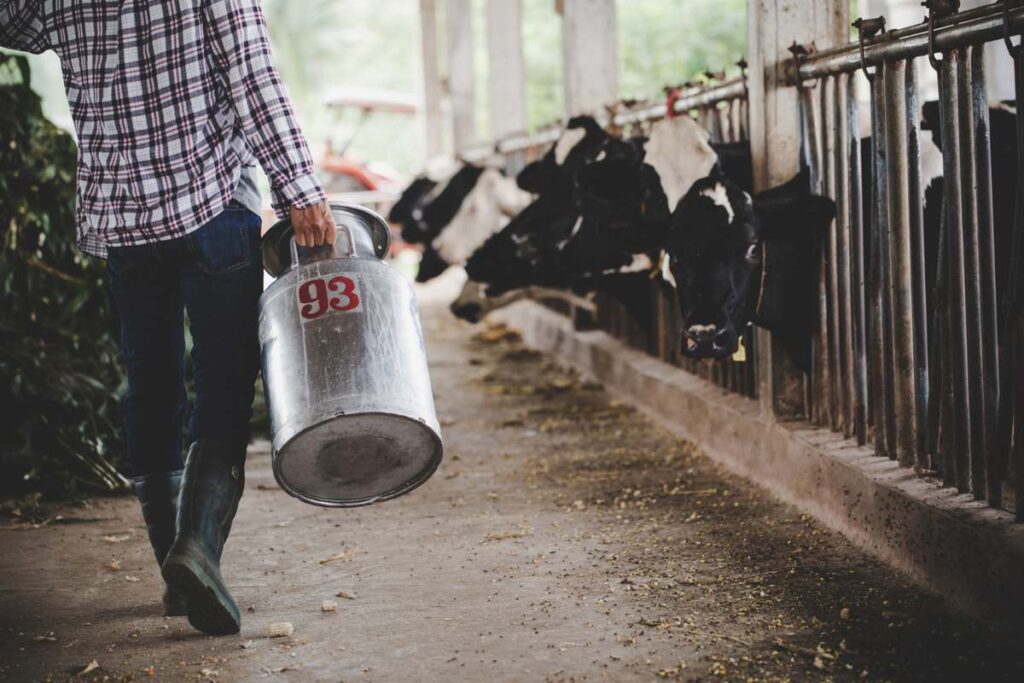
Dairy farming is the practice of raising cattle, buffaloes, or other milk-producing animals to produce milk and dairy products such as butter, cheese, yogurt, and ghee. It requires proper breed selection, balanced nutrition, and efficient farm management to ensure high milk yield and quality. Dairy farmers must maintain hygiene, provide regular veterinary care, and adopt modern milking techniques to improve productivity. With the growing demand for organic and fresh dairy products, sustainable practices like organic feed, pasture-based grazing, and value-added dairy processing can increase profitability. Dairy farming is a lucrative agribusiness that supports rural livelihoods and contributes significantly to the food industry.
How to Start Dairy Farming
- Learn about different dairy cattle breeds (e.g., Holstein, Jersey, Murrah buffalo).
- Decide on the scale of farming (small-scale, medium, or commercial dairy farm).
- Analyze the market demand for milk and dairy products.
- Choose a spacious area with access to clean water and good ventilation.
- Ensure the land has proper drainage to keep the environment hygienic.
- Set up separate areas for feeding, milking, and storage.
- Buy healthy cows or buffaloes from trusted breeders or dairy farms.
- Ensure the animals are disease-free and have high milk yield potential.
- Register with a veterinary service for regular health check-ups.
- Provide a balanced diet with green fodder, dry fodder, and dairy supplements.
- Follow hygienic milking practices (hand or machine milking).
- Use stainless steel containers or cooling tanks for milk storage.
How to Sell The Product
- Supply fresh milk to local dairies, milk collection centers, and cooperatives.
- Sell directly to households, tea shops, sweet shops, and restaurants.
- Partner with milk delivery services for daily supply to urban customers.
- Sell milk in bulk to large dairy brands like Amul, or local milk processing units.
- Partner with cheese, butter, and ghee manufacturers to supply raw milk.
- Set up a small-scale processing unit to make ghee, paneer, yogurt, or flavored milk.
- Sell dairy products at local grocery stores, supermarkets, and organic food stores.
- Use WhatsApp, social media, and websites for direct orders and online bookings.
- Supply fresh milk, cream, and butter to hotels, bakeries, and dessert shops.
- Set up a stall in farmers’ markets, food fairs, or health expos.
- If producing at a large scale, export dairy products to neighboring states or countries.
9. Fish Farming (Aquaculture)

Fish farming (Aquaculture) is the practice of breeding, raising, and harvesting fish and other aquatic organisms in controlled environments such as ponds, tanks, or cages. It is a profitable agribusiness that provides a steady supply of fish for consumption while reducing pressure on wild fish populations. Common species for fish farming include catfish, carp, and shrimp. Successful fish farming requires proper water quality management, balanced nutrition, and disease control. With the rising global demand for seafood, fish farming offers a sustainable solution to meet market needs while providing employment opportunities and economic benefits to farmers.
How to Start Fish Farming
- Decide on the type of fish farming (pond-based, tank-based, or RAS – Recirculating Aquaculture System).
- Choose suitable fish species such as catfish, carp, prawns, or shrimp based on local demand.
- Study the market demand, cost, and profitability of fish farming.
- Choose a site with access to clean water, good drainage, and electricity.
- Ensure the land is suitable for constructing ponds or installing tanks.
- Ensure proper aeration and filtration systems to maintain water quality.
- Buy high-quality fingerlings (young fish) or fish seeds from trusted hatcheries.
- Choose disease-resistant and fast-growing fish breeds for higher yield.
- Provide a nutrient-rich diet with commercial or homemade fish feed.
- Regularly monitor fish health and prevent diseases using proper treatments.
- Keep records of fish weight and size to track growth progress.
- Harvest fish once they reach market size (typically 4-6 months, depending on species).
- Use proper techniques for catching and storing fish to maintain freshness.
- Process fish (cleaning, filleting, freezing) for higher market value.
How to Sell The Product
- Supply fresh fish to local fish markets and seafood vendors.
- Partner with fishmongers, wholesalers, and roadside seafood sellers.
- Partner with hotels, restaurants, and seafood outlets for regular supply.
- Sell directly to supermarkets, grocery stores, and organic food shops.
- Provide processed fish fillets, frozen fish, or pre-packaged seafood for convenience.
- Set up a fish delivery service for fresh seafood lovers.
- Use WhatsApp, Facebook, or Instagram for direct orders and home deliveries.
- List products on e-commerce platforms like Amazon, or seafood-specific websites.
- Create a website or mobile app for fresh fish orders.
- Sell in bulk to fish processing units that produce canned, smoked, or dried fish.
- If producing at a large scale, export seafood to international markets.
- Set up a stall at local farmers’ markets or organic food expos.
10. Vermicomposting

Vermicomposting is the process of producing organic fertilizer using earthworms to decompose organic waste materials such as kitchen scraps, farm residues, and biodegradable waste. The worms consume the organic matter and excrete nutrient-rich vermicast (worm compost), which improves soil fertility and plant growth. This eco-friendly method enhances soil aeration, moisture retention, and microbial activity, making it ideal for sustainable agriculture and organic farming. Vermicomposting is a low-cost, high-yield business that reduces waste, promotes environmental sustainability, and provides farmers and gardeners with a natural alternative to chemical fertilizers.
How to Start Vermicomposting
- Learn about different earthworm species suitable for composting (e.g., Eisenia fetida, Eudrilus eugeniae).
- Understand the process, market demand, and profitability of vermicomposting.
- Select a suitable site (indoor, outdoor, or greenhouse setup).
- Choose a composting bin, wooden box, or pit depending on space availability.
- Ensure proper aeration and drainage to maintain moisture balance.
- Place the bin in a shaded area, away from direct sunlight and heavy rain.
- Buy high-quality composting earthworms from a trusted supplier.
- Use coconut coir, shredded paper, dry leaves, or aged manure as bedding material.
- Add organic waste like vegetable peels, fruit scraps, coffee grounds, and dry leaves.
- Keep the moisture level at 40-50% by sprinkling water if needed.
- Turn the compost occasionally for aeration and faster decomposition.
- Protect worms from pests, ants, or rodents.
- The compost is ready in 45-60 days when it turns dark, crumbly, and earthy-smelling.
- Separate the worms using light exposure or mesh screens.
- Store vermicompost in dry, breathable bags to maintain quality.
How to Sell The Product
- Directly supply organic farmers, horticulturists, and greenhouse owners.
- Sell at local agricultural markets, farm supply stores, and nurseries.
- Sell vermicompost to plant nurseries, garden centers, and landscaping businesses.
- Offer packaged vermicompost in different sizes (1kg, 5kg, 10kg bags) for home gardeners.
- List products on Amazon, and local agricultural e-commerce platforms.
- Create a Facebook, Instagram, or WhatsApp Business page to take orders directly.
- Offer home delivery in urban areas where organic gardening is popular.
- Set up a stall at farmers’ markets, organic food expos, and agricultural fairs.
- Offer free samples and educate farmers on the benefits of using vermicompost.
- Supply vermicompost to schools, colleges, and universities for eco-awareness programs.
Conclusion
Agriculture offers numerous profitable business opportunities for entrepreneurs looking to generate income while contributing to food production and sustainability. From organic vegetable farming, mushroom cultivation, and poultry farming to vermicomposting, hydroponic farming, and beekeeping, each agribusiness has the potential to yield significant profits with proper planning and management. Businesses like fish farming, goat farming, dairy farming, and plant nurseries provide steady returns and can be expanded over time. With the increasing demand for organic and sustainable products, innovative farming methods and smart marketing strategies can help agripreneurs build successful ventures. By leveraging modern technology, government support, and e-commerce platforms, agriculture can be transformed into a highly rewarding business sector.


